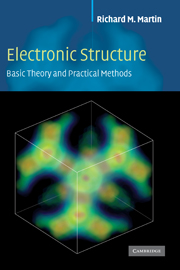Book contents
- Frontmatter
- Contents
- Preface
- Acknowledgments
- Notation
- Part I Overview and background topics
- Part II Density functional theory
- Part III Important preliminaries on atoms
- Part IV Determination of electronic structure: the three basic methods
- Part V Predicting properties of matter from electronic structure – recent developments
- 18 Quantum molecular dynamics (QMD)
- 19 Response functions: phonons, magnons, …
- 20 Excitation spectra and optical properties
- 21 Wannier functions
- 22 Polarization, localization, and Berry's phases
- 23 Locality and linear scaling O(N) methods
- 24 Where to find more
- Appendix A Functional equations
- Appendix B LSDA and GGA functionals
- Appendix C Adiabatic approximation
- Appendix D Response functions and Green's functions
- Appendix E Dielectric functions and optical properties
- Appendix F Coulomb interactions in extended systems
- Appendix G Stress from electronic structure
- Appendix H Energy and stress densities
- Appendix I Alternative force expressions
- Appendix J Scattering and phase shifts
- Appendix K Useful relations and formulas
- Appendix L Numerical methods
- Appendix M Iterative methods in electronic structure
- Appendix N Code for empirical pseudopotential and tight-binding
- Appendix O Units and conversion factors
- References
- Index
19 - Response functions: phonons, magnons, …
from Part V - Predicting properties of matter from electronic structure – recent developments
Published online by Cambridge University Press: 05 June 2012
- Frontmatter
- Contents
- Preface
- Acknowledgments
- Notation
- Part I Overview and background topics
- Part II Density functional theory
- Part III Important preliminaries on atoms
- Part IV Determination of electronic structure: the three basic methods
- Part V Predicting properties of matter from electronic structure – recent developments
- 18 Quantum molecular dynamics (QMD)
- 19 Response functions: phonons, magnons, …
- 20 Excitation spectra and optical properties
- 21 Wannier functions
- 22 Polarization, localization, and Berry's phases
- 23 Locality and linear scaling O(N) methods
- 24 Where to find more
- Appendix A Functional equations
- Appendix B LSDA and GGA functionals
- Appendix C Adiabatic approximation
- Appendix D Response functions and Green's functions
- Appendix E Dielectric functions and optical properties
- Appendix F Coulomb interactions in extended systems
- Appendix G Stress from electronic structure
- Appendix H Energy and stress densities
- Appendix I Alternative force expressions
- Appendix J Scattering and phase shifts
- Appendix K Useful relations and formulas
- Appendix L Numerical methods
- Appendix M Iterative methods in electronic structure
- Appendix N Code for empirical pseudopotential and tight-binding
- Appendix O Units and conversion factors
- References
- Index
Summary
Summary
Many properties of materials – mechanical, electrostatic, magnetic, thermal, etc. – are determined by the variations of the total energy around the equilibrium configuration, defined by formulas such as (2.2)–(2.7). Experimentally, vast amounts of information about materials are garnered from studies of vibration spectra, magnetic excitations, and other responses to experimental probes. This chapter is devoted to the role of electronic structure in providing predictions and understanding of such properties, through the total energy and force methods described in previous chapters, as well as recent advances in efficient methods for calculation of response functions themselves. Through these developments, calculation of full phonon dispersion curves, dielectric functions, infrared activity, Raman scattering intensities, magnons, anharmonic energies to all orders, phase transitions, and many other properties have been brought into the fold of practical electronic structure theory.
The primary properties considered in previous chapters are the total energy and (generalized) forces. These are sufficient to treat a vast array of problems including stability of structures, phase transitions, surfaces and interfaces, spin polarization, “ab initio” molecular dynamics, etc. One can also use such direct methods to calculate all the derivatives of the energy with respect to perturbations, by carrying out full self-consistent calculations for various values of the perturbation, and extracting derivatives from finite difference formulas. This has been used very successfully, for example, in the “frozen phonon” method illustrated in Fig. 2.8 and described further in Sec. 19.2.
- Type
- Chapter
- Information
- Electronic StructureBasic Theory and Practical Methods, pp. 387 - 405Publisher: Cambridge University PressPrint publication year: 2004



